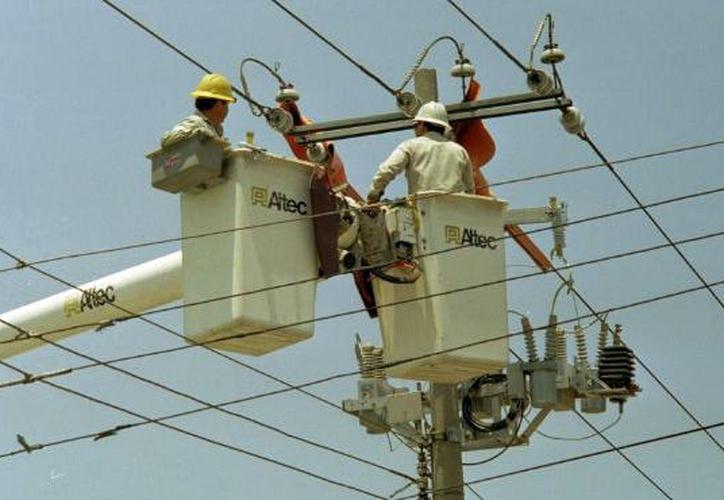According to the general director of the fuel trading subsidiary CFEnergía, Miguel Santiago Reyes Hernández, two liquefied natural gas ships will be purchased and will arrive through Manzanillo, Colima, and Altamira, Tamaulipas, in the next few hours.
MEXICO (Agencies) – An enormous winter storm front in Texas reduced natural gas supply, used for combined cycle plants in northern Mexico. It took almost 5,500 megawatts out of the system and caused a blackout in northern states; the state-owned company will purchase gas that will be brought in via ships.
After Monday morning’s blackout that left 4.7 million customers of the Federal Electricity Commission (CFE) in the north and northeast of the country (13% of the national total) without energy, new incidents are expected in this area. The northwest and Bajio for the next four days, derived from the fact that due to extreme cold in the south of the United States, the supply of natural gas to Mexico will continue to be restricted. The Electric Reliability Council of Texas decreed the maximum alert, which will last between February 14 and 19 of this year.
According to the CFE, gas consumption increased and renewable generation decreased, and hydrocarbon production was reduced by half. They are proposing that there will be controlled blackouts, meeting energy demands with other technologies, in this case, even dispatching highly polluting units to ensure the reliability of its electrical system.
Besides, one of the most important pipelines in the United States, El Paso Natural Gas, which runs parallel to those in Mexico and crosses Sonora and Chihuahua, operated by Carso, has declared a situation fortuitous event or force majeure. No gas is circulating through it.
There is no gas transportation through this pipeline, which means that the entire Northwest Zone’s gas restrictions will continue in the next few hours. In Monday’s incident, 5,323 megawatts went out of operation, of which 3,339 correspond to external energy producers and 1,984 to the CFE, explained Carlos Morales Mar, Director of Generation Operations of the CFE. As of Monday afternoon’s report, 65% of the interruptions had been reestablished.
Regarding the contingency management, CFE informed that it has available more than 11,328 megawatts from other generation sources, such as hydroelectric, totaling 7,457 megawatts, to reestablish the electric service. The capacity of the coal-fired power plants and natural gas shipments through two vessels in Manzanillo and Altamira will be added.
The generating plants that the CFE has made available to the National Energy Control Center (Cenace) to face this contingency are: Tula, Salamanca, Manzanillo, Baja California I, II, III, IV, and V; Topolobampo, Guerrero Negro, and Puerto Libertad in the northwest of the country; Altamira, Samalayuca, Lerma, Villa de Reyes and the power plants of the Yucatan peninsula, such as Merida and Valladolid. “According to the weather reports, we expect that tomorrow the temperatures will improve; and with better temperatures, we will be able to normalize the gas supply,” said the company’s executive.
Contingency will cost $20 billion.
This lack of natural gas supply from Texas was due to the low temperatures registered since Saturday. This phenomenon caused the stoppage of a generation capacity of 5,323 megawatts per hour in the national transmission system, which produced an imbalance that left 4.7 million customers without energy.
According to the general director of the fuel trading subsidiary CFEnergia, Miguel Santiago Reyes Hernandez, two liquefied natural gas ships will also be purchased and will arrive through Manzanillo Colima and Altamira Tamaulipas in the next hours.
Gas is being purchased at 200 dollars per thousand BTUs since the unusual drop in temperature in Texas began because gas consumption in the neighboring country to the north rose from 123,000 to 136,000 million BTUs and production in gas fields fell by half in the last hours. “The expected impact in budgetary terms is of 20,000 million pesos in these four days. Those 20,000 million pesos, given that they have entered a critical alert, would be prorated and absorbed over 12 months, in such a way that we hope that there will be no effects on the electricity tariff”, said the state official.
AMLO rules out boycott in a power outage
After the massive blackout that left millions of users without electricity in the north of the country, early in the morning, President Andrés Manuel López Obrador blamed the power failure on lousy weather due to a winter storm and ruled out that it was due to a boycott. “Yes, there is this blackout in Nuevo León, Coahuila, Tamaulipas, and Chihuahua. It is due to the winter storm, due to bad weather. The Federal Electricity Commission technicians are already working,” he emphasized from the National Palace.
AMLO stated that the failure had affected 400 thousand users. Later on, the Federal Electricity Commission (CFE) corrected the figure to 5 million affected in Nuevo Leon, Tamaulipas, Chihuahua, Coahuila, Durango, Sinaloa, and Sonora.
AMLO said that the Federal Commission’s technicians were already working to reestablish the service, while confirming that since Saturday, February 13, they had been aware of this blackout probability occurring; however, he considered that there was the certainty that it would be short-lived.
As is his custom, he dedicated time to criticize those who are against his energy reform, saying: “those who are against the electricity reform” that he proposed before Congress have gone to the media both in Mexico and abroad “wanting to scare us that it will affect Mexico because it is a violation of the treaty (USMCA), which is not true.”


